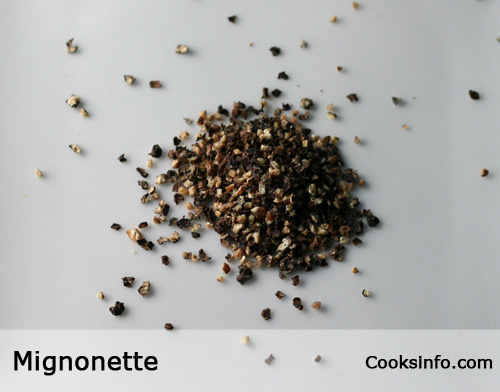
Mignonette. © Denzil Green
Mignonette is a term used in French cooking. The word literally means “cute.”
In actual practice, it can mean several different things according to context.
Ground pepper
The most common meaning appears to be coarsely-ground pepper.
The peppercorns can be black or white (there’s a modern misconception that only white peppercorns are meant.)
To ensure a proper “mignonette”, with only coarse pieces of pepper, shake the coarsely-ground pepper in a sieve to allow the too-finely ground pieces to fall through, leaving you with just the coarse pieces.
A mignonette of pepper is used to make steak au poivre, and mignonette sauce (a pepper sauce typically served with raw oysters.)
Cooked meat assortment
The term mignonette has been used for an assortment of small, coated and fried pieces of meat:
The name is also used for elaborate preparations of noisettes of lamb, suprêmes of chicken, filet mignon, etc. Escoffier created mignonettes of chicken (suprêmes cut into rounds and studded with pickled tongue and truffle) and mignonettes of foie gras (small slices coated with chicken mousseline, dipped in egg and breadcrumbs, and sautéed).” [1] Lang, Jennifer Harvey, ed. Larousse Gastronomique. New York: Crown Publishers. 1988. Page 680.
Potatoes
“Potatoes cut into thick matchsticks are also called mignonettes.” [2]Larousse Gastronomique 1988. Page 680.
Bouquet garni
The word mignonette was also a name for something that was like a bouquet garni. It was a sachet made of muslin, containing within it cinnamon, cloves, coriander, ginger, nutmeg and red pepper. It was dipped a few times in a pot of food to season the contents of the pot. The spice bundle would then be dried out again, and used several times.
Literature
Jacques Pépin gives the following directions for making a mignonette.
Crush whole grain pepper with a rolling pin or the bottom of a heavy casserole, spreading them out and pushing them back and forth. You can hear them cracking. Repeat until the smallest grains are crushed. Crushed peppercorns are called ‘mignonette.’ Black pepper is more popular than white pepper because it is more fragrant and less pungent.” [3]”Écraser du poivre en grains avec un rouleau ou le rebord d’une lourde casserole, en les étalant et les poussant d’en avant en arrière. On peut les entendre craquer. Recommencer jusqu’à ce que les grains les plus petis soient écrasés. Les grains de poivre écrasés sont appelés ‘mignonnette.’ Le poivre noir est plus apprécié que le poivre blanc car il est plus parfumé et moins piquant.” — Pépin, Jacques. La Technique: Un guide illustré des techniques fondamentales de l’art culinaire. Montréal: Les Éditions Optimum Limitée. 1978. Page 268.
Sources
New Larousse Gastronomique. Paris: Librairie Larousse. English edition 1977. Page 589.
Larousse Gastronomique. New York: Crown Publishers. 1988. Page 680.
References
| ↑1 | Lang, Jennifer Harvey, ed. Larousse Gastronomique. New York: Crown Publishers. 1988. Page 680. |
|---|---|
| ↑2 | Larousse Gastronomique 1988. Page 680. |
| ↑3 | ”Écraser du poivre en grains avec un rouleau ou le rebord d’une lourde casserole, en les étalant et les poussant d’en avant en arrière. On peut les entendre craquer. Recommencer jusqu’à ce que les grains les plus petis soient écrasés. Les grains de poivre écrasés sont appelés ‘mignonnette.’ Le poivre noir est plus apprécié que le poivre blanc car il est plus parfumé et moins piquant.” — Pépin, Jacques. La Technique: Un guide illustré des techniques fondamentales de l’art culinaire. Montréal: Les Éditions Optimum Limitée. 1978. Page 268. |

